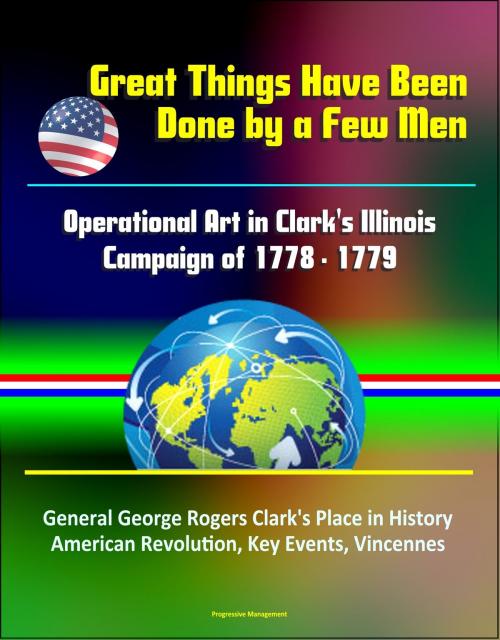Great Things Have Been Done by a Few Men: Operational Art in Clark's Illinois Campaign of 1778 - 1779 - General George Rogers Clark's Place in History, American Revolution, Key Events, Vincennes
Nonfiction, History, Americas, United States, Revolutionary Period (1775-1800), Military| Author: | Progressive Management | ISBN: | 9781311001702 |
| Publisher: | Progressive Management | Publication: | April 18, 2016 |
| Imprint: | Smashwords Edition | Language: | English |
| Author: | Progressive Management |
| ISBN: | 9781311001702 |
| Publisher: | Progressive Management |
| Publication: | April 18, 2016 |
| Imprint: | Smashwords Edition |
| Language: | English |
This excellent report has been professionally converted for accurate flowing-text e-book format reproduction. No longer the purview of generals, American brigade and battalion commanders increasingly employ operational art. They execute campaigns with implications spanning all levels of war. Historical vignettes depicting field grade commanders using operational art are sparse. But the practice is not new to American military history. George Rogers Clark's Illinois campaign may provide an example where an eighteenth century field grade theater commander employed operational art using a small, independent force.
Lieutenant Colonel George Rogers Clark led a bold campaign to reverse Britain's attempts to destroy Virginia's frontier settlements during the American Revolution. Between 1778 and 1779, he captured the Illinois region with just one hundred and seventy-five men, forced his adversary, Lieutenant Governor Henry Hamilton, into battle and defeated him in a surprise maneuver at Vincennes. This victory saved Kentucky and denied potential British-Indian penetrations east of the Appalachians might have altered critical events leading to Yorktown.
This monograph analyzes how Clark linked the tactical employment of forces to achieve strategic objectives. It assesses whether Clark exhibited operational vision. It considers whether his campaign demonstrated the hallmark of operational art. And it evaluates Clark's operational flexibility through the techniques used to maintain the operational aim.
The American Revolution in the West is inappropriately characterized as endless local skirmishes. Such depiction distorts the reality of Clark's operations. He continually balanced between offensive, defensive, and stability operations to achieve a strategic objective tied directly to the casus belli in the Declaration of Independence. As a result, the Illinois Campaign provides a narrative at the very roots of America's military heritage relevant to the future conflicts. One that demonstrates operational art is less about an era, formation, or technology and more about the scale, scope, and synchronization of action relative to the strategic aim. It is about achieving effectiveness in war.
Introduction * George Rogers Clark's Place in History * Campaign Background * Strategic Situation: 1763 - 1775 * British Operations: April 1775 - March 1777 * Hamilton's Indian Offensive: March 1777 - April 1778 * Clark's Illinois Campaign * Designs, Plans, and Orders: April 1777 - January 1778 * Preparation: January - June 1778 * Attack, Exploitation, and Consolidation: June - September 1778 * Hamilton's Counteroffensive: September 1778 - February 1779 * Spoiling Attack, Security, Transfer to Civil Authority: February - June 1779 * Stability, Defense and Strategic Culmination: 1779 - 1783 * Clark's Illinois Campaign as Operational Art * Operational Vision * The Hallmark of Operational Art * Operational Flexibility * Conclusion * APPENDIX A: Timeline of Key Events * APPENDIX B: Clark's Operational Concept * APPENDIX C: Clark's Instructions * APPENDIX D: Clark's Letter Before His Attack on Vincennes * APPENDIX E: Key to Military Symbols * BIBLIOGRAPHY
This excellent report has been professionally converted for accurate flowing-text e-book format reproduction. No longer the purview of generals, American brigade and battalion commanders increasingly employ operational art. They execute campaigns with implications spanning all levels of war. Historical vignettes depicting field grade commanders using operational art are sparse. But the practice is not new to American military history. George Rogers Clark's Illinois campaign may provide an example where an eighteenth century field grade theater commander employed operational art using a small, independent force.
Lieutenant Colonel George Rogers Clark led a bold campaign to reverse Britain's attempts to destroy Virginia's frontier settlements during the American Revolution. Between 1778 and 1779, he captured the Illinois region with just one hundred and seventy-five men, forced his adversary, Lieutenant Governor Henry Hamilton, into battle and defeated him in a surprise maneuver at Vincennes. This victory saved Kentucky and denied potential British-Indian penetrations east of the Appalachians might have altered critical events leading to Yorktown.
This monograph analyzes how Clark linked the tactical employment of forces to achieve strategic objectives. It assesses whether Clark exhibited operational vision. It considers whether his campaign demonstrated the hallmark of operational art. And it evaluates Clark's operational flexibility through the techniques used to maintain the operational aim.
The American Revolution in the West is inappropriately characterized as endless local skirmishes. Such depiction distorts the reality of Clark's operations. He continually balanced between offensive, defensive, and stability operations to achieve a strategic objective tied directly to the casus belli in the Declaration of Independence. As a result, the Illinois Campaign provides a narrative at the very roots of America's military heritage relevant to the future conflicts. One that demonstrates operational art is less about an era, formation, or technology and more about the scale, scope, and synchronization of action relative to the strategic aim. It is about achieving effectiveness in war.
Introduction * George Rogers Clark's Place in History * Campaign Background * Strategic Situation: 1763 - 1775 * British Operations: April 1775 - March 1777 * Hamilton's Indian Offensive: March 1777 - April 1778 * Clark's Illinois Campaign * Designs, Plans, and Orders: April 1777 - January 1778 * Preparation: January - June 1778 * Attack, Exploitation, and Consolidation: June - September 1778 * Hamilton's Counteroffensive: September 1778 - February 1779 * Spoiling Attack, Security, Transfer to Civil Authority: February - June 1779 * Stability, Defense and Strategic Culmination: 1779 - 1783 * Clark's Illinois Campaign as Operational Art * Operational Vision * The Hallmark of Operational Art * Operational Flexibility * Conclusion * APPENDIX A: Timeline of Key Events * APPENDIX B: Clark's Operational Concept * APPENDIX C: Clark's Instructions * APPENDIX D: Clark's Letter Before His Attack on Vincennes * APPENDIX E: Key to Military Symbols * BIBLIOGRAPHY















